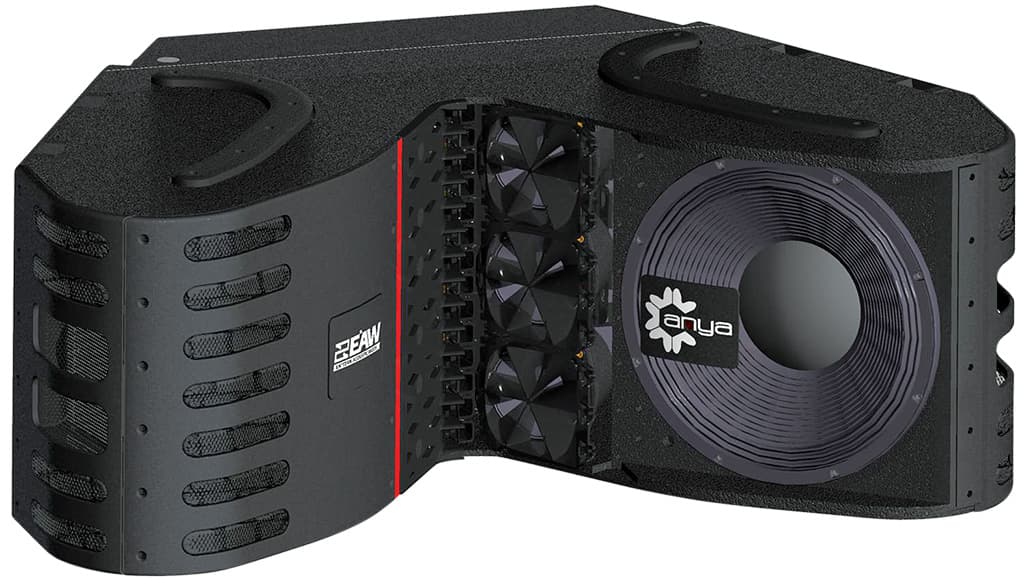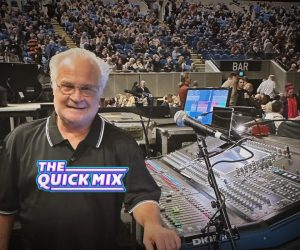
Inside EAW’s Anya
With its ‘hang it straight then steer it later’ philosophy, Anya’s approach to pattern control leads the way.
There are many ways to launch a product. If you’re Richard Branson, you’re likely to wear a kilt, be surrounded by a bevy of comely beauties, and, with the guarantee of some kinda stunt, attract half the world’s media. More traditionally for our industry, you rock up to a trade show and put out a press release. Anya was effectively launched at last year’s Coachella festival, when Rat Sound took some pre-release product and let it loose at the Palm Springs music festival. And I recall that my first ‘look’ at Anya was via a Dave Rat Instagram.
Not sure if EAW has officially launched Anya yet, but gradually more info trickles out of Whitinsville. There’s the whiff of nonchalance about its introduction.
That’s appearances anyway. I’ve no doubt EAW is anything but nonchalant about Anya. By its own lofty standards, EAW has been in the wilderness for 10 years or more. EAW is accustomed to being at the top of the heap and having popular, sophisticated gear that rocks. Anya may well put it back on top again and lead the way for some time to come.
Anya embodies the logical extension of the latest thinking behind line array and how to attain the best pattern control. Essentially, the idea is: the more channels of amplification and processing you can squeeze into a box, the more control you have over what comes out of the box. Martin Audio’s MLA series ratcheted up the stakes by making all of its driver components individually addressable. In so doing, MLA can fine-tune its coverage pattern better than your average tri-amped line array. Still, to achieve the coverage required (to simultaneously get way up the back and cover the first row), MLA needs to be splayed in the now-familiar J hang.
Why not flat and straight? Let’s get into the way-back machine and find out:
MORE PLEASE, OF EVERYTHING
If we go back to the dawn of line array, it was recognised by acoustician Harry Olsen (mid-last century) that stacking speaker drivers produced pattern control. But it would take technological advances and some real ingenuity for line array theory to be truly useful in concert PA systems. Then L-Acoustics’ Christian Heil cracked the code, and devised the WST HF waveguide to produce full-range coupling. (Still confused? Have a scoot through Dave Rat’s box item.) Ever since, all modern ‘line source’ arrays have followed a similar approach, until now.
It’s taken another technological leap to allow Anya to exist. HF devices, digital amps and processing have all either got: better, cheaper, more powerful, or all of the above.
So whereas V-DOSC (with its 2 x 15s, 4 x 7s and 2 x HFs) has/had eight drivers, Anya has 22 — and each has its own amp channel and is addressed by its own processing channel. Crucially, of those 22 devices, 14 are its brand new (one-inch exit/38mm voice coil) HF compression drivers, loaded on a HF horn that expands to fill nearly the entire face of the enclosure.
CONTACT
Production Audio & Video Technology
(03) 9264 800
sales@productionaudio.com.au
www.productionaudio.com.au
Production Audio has a demo system in stock and will be road-testing it, with a launch event coming soon. Be sure to get in contact to register your interest in ANYA.

NEW GEAR’S RESOLUTION
With its 2 x 15s, Anya is a large-format line array system but its ‘resolution’ is far greater than similar products. By which I mean, with all those individually addressed drivers, the analogy is somewhat like building your model out of Lego instead of Duplo — the degree of fine-tuning is vastly increased with Lego because the building blocks are smaller and you have more of them to play with in the space allowed.
What’s more, with the extra ‘resolution’ afforded by the extra ‘circuits’ per box, Anya’s response is potentially a lot more natural. Traditionally, line arrays need serious DSP turbo-charging and a whole bunch of compensation elsewhere to get those two or three HF units in a box to be heard 100m+ away, while ensuring the overall response to sound half-natural. With Anya, the high resolution of transducers allows for the use of drivers that aren’t working as hard or being asked to work beyond their normal limits. “Gone are the break up modes of large format compression drivers,” says EAW’s CEO Jeff Rocha.
Rocha also explains: “The basic un-adapted Anya acoustics package is outstanding,” he said. “So beyond the application of EAW Focusing [which irons out the speaker box frequency/phase anomalies], only minimal processing is required to deliver some radical changes to the shape of the wavefront. Despite the abundance of on-board DSP, Anya does not suffer from the tonal degradation associated with overly processed sound systems because the relative change from device-to-device is very small.”
ROOM OUT OF THE EQUATION
These ‘radical’ changes to the wavefront mean you no longer need to splay the array to achieve the required coverage. Anya is hung flat. Any coverage alteration is handled electronically, and not mechanically. With the extra resolution, the precision you can bring to the changes in coverage pattern is quite extraordinary. Jeff Rocha again: “Anya tailors coverage so precisely to the audience area that the impact of room acoustics on fidelity is significantly reduced. Taken all together, these factors produce an infinitely scalable, large-format system that has the impact of a big PA but the fidelity of an enormous pair of studio monitors.”
And look, I know he would say that. He’s EAW’s boss and one of the masterminds behind Anya and, as yet, not many outside of California have heard Anya in full flight.
One person who has heard Anya in action more than most is Dave Rat.
Again, Dave isn’t totally disinterested. He’s good mates with EAW and was sold on Anya early. But he’s primarily a bloke who runs a rental company (Rat Sound) who can ill afford some vanity-led flight of technological fancy.
RATTING ON ANYA
Dave Rat: I’ve worked with EAW on the Microwedge floor monitors. They licensed that product and they’ve been manufacturing and selling that, and the relationship has been great. So it wasn’t a complete surprise to be contacted about the Anya project.
To be clear: nothing about Anya is my idea. EAW came up with the idea; they’re the brilliant MIT graduates; they’ve got all the technical stuff down… But when it comes to putting those ideas into the real world; making it interface with the human race… that’s what I’m good at.
AT: What was your initial ‘real world’ perspective?
Dave Rat: ‘That’s never going to happen!’ My next reaction was: ‘Sure, I’ll consult on that! What’s the worst thing that could happen? It’ll never come to fruition but it’ll be interesting to watch them try.’ Next thing I know: ‘Alright, we’re ready. Come listen to a box.’ I thought: ‘Holy shit! This thing is real?!’
AT: Are advances in component technology just as much responsible for Anya as clever thinking?
Dave Rat: If what you’re saying is: the drivers have got small enough, light enough and loud enough; that the Class-D amplifiers got small enough, light enough and cheap enough to put 22 into a cab; and the digital processing costs have come down enough and are high quality enough… sure. All that created the mechanical ability for Anya to exist. But then they needed to create the software and processing in order to bring it to life.
AT: With so much potential control, I’m guessing the software runs quite deep?
Dave Rat: EAW historically over-complicates things. And I think they were wary of making that mistake here. The software simplifies the process rather than opens a can of worms. Effectively, what you do is give the software the room dimensions and it will then distribute the energy as uniformly as possible and with as equal a frequency response as possible.
AT: I guess the theory is: with great power comes great responsibility… or at least more ways in which the PA can go spectacularly wrong.
Dave Rat: And there are some very clever fail safes. For example, every cab has infrared sensors. So Anya is ‘self aware’. The cab at the bottom of the array knows that, because it can’t sense another below it. And so on. The array is self-determining which mean the processing can’t go spectacularly wrong.
There’s also a microphone in every box that allows it to do a self-test. The speaker makes noise and analyses itself and lets you know if there’s something wrong.
AT: How will the ‘hang it, then steer it’ capabilities be so much more useful than model it/splay it/hang it?
Dave Rat: Here’s an example: Say you have Anya installed into a theatre and you’ve not sold the balcony tonight. Without moving anything you can steer the entire array to the floor area. Maybe there’s a late rush on tickets and they open the balcony in the middle of the show. No problem, you can steer the entire PA to include the balcony.
Or, say you’ve got a festival rig that’s designed to cover 10,000 people in a paddock. But 15,000 show up. You can expand the coverage of the rig without lifting a finger.
Or, say you’ve got noise complaints during an outdoor gig. You can reduce the long-throw portion of the PA in real-time while you’ve got the official on the two-way radio. All without compromising the show, or lowering/raising the PA.
AT: What does Anya sound like?
Dave Rat: The short answer is: it sounds great. But I’ll tell you this anecdote about the sound during testing:
We had the rig set up in a factory space. I was listening intently to see if I could hear anything odd; any aberrations. I’m extremely familiar with the sound of the Microwedge, so I had a Microwedge 15 set up in the same space as the two Anya boxes. Just for comparison’s sake we tried to EQ Anya to replicate as best we could the sound of the Microwedge. Without much luck. Anyway, we were listening to Anya, hearing it in different coverage configurations. Set to full 180°, where it was shooting straight up and straight down, it turned the space into a big echo chamber — it was almost unintelligible. And then I said, “Now just cover up to the mix position,” and all of a sudden the sound became clear and tight. The difference was dramatic and then I said, “Wait a minute, can you set the coverage of the Anya to match the Microwedge’s at 60° conical?”
So the EAW guys set it up and I got goose bumps, because suddenly when the coverage patterns were mirrored, and even though the systems were unrelated in every other way, they sounded way more similar than when we were trying to match them tonally with EQ. I realised what we as engineers often think is EQ-based, and what our measurement systems tell us is EQ-based, is probably just as much coverage based. It’s the way our brain interprets room reflections and the character of the room that’s being excited. And with Anya, being able to control its dispersion in real-time, well, suddenly that’s a capability you can’t un-hear — once you’ve heard it, you’re hooked.
AT: So you’re saying that a PA will often compare more poorly/favourably because of how much or little it’s exciting the room, rather than any inherent ‘sound’?
Dave Rat: Anya isn’t the only great-sounding PA on the market. There are a number. But if we were able to eliminate reflections in a room, every room would sound the same and perfect. That’s where Anya comes to the rescue.
With reflections, the sound system is one output, the floor is one reflection, left wall, right wall, ceiling and then rear wall. That’s five different versions of the system we’re hearing, then double that per hang. There are 10 different primary reflections showing up in a square-box-type room. In an arena, with all its concave surfaces, who knows?!
So will people like the sound of Anya more than K1 or the J line? People have their preferences. But Anya has the capability to reduce one of the primary issues, unwanted reflections, more significantly than any other system we have, in real time, resulting in a better sounding show than we can get with other systems.
OH… & ANOTHER THING
The gripe many have had about large-format line array (and why Nexo chose to pursue its modular STM rather than yet another big three-way box) is that even though they’re ideal for outdoor festivals, in most other applications they’re unwieldy and inflexible — you’re probably better off with a point ’n’ shoot PA. With most line array elements covering less than 15° in the vertical, you need at least five a side to cover an average-sized room, when in every other regard that’s just way too much PA.
Anya doesn’t work this way. If the room needs only two boxes a side, then hang two boxes.
Or think of it this way: without the use of electronic beam steering, you need a good number of line array elements — say five or six — to get any of the pattern control goodness in the mids and lows afforded by line array theory. Put only a couple of boxes up and you might get highly directional horn-loaded highs and high/mids but the lows are all-but omnidirectional.
Not so with Anya. With its electronic beam steering and processing, you have full-band control.
If EAW gets the package right — and let’s hope, given the company’s pedigree, that’s a ‘given’ — then it’s hard to see how system designers, installers and rental companies won’t immediately be sold on the benefits of Anya. I’ve no doubt it’ll be a pricey option, but you’re not compelled to buy into a hefty minimum to have any system at all — two a side would make for a very handy club system, for example.
Is it the next big thing? Just perhaps. Anya will at the very least give the rusted-on EAW-philes — of which there are many — something to cheer about.
















RESPONSES